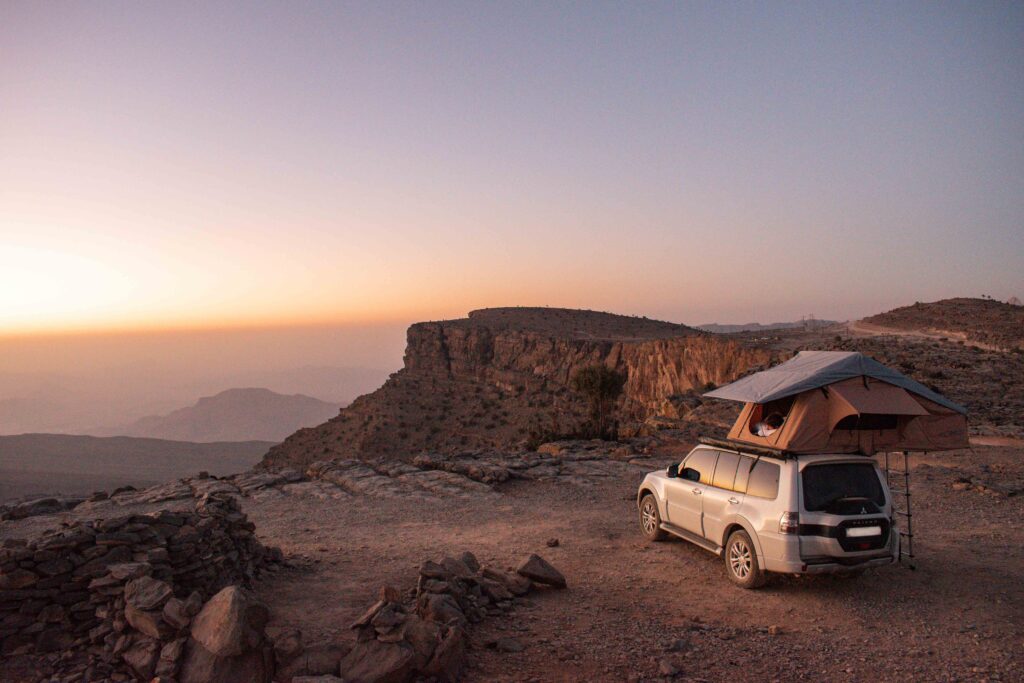
If you are an outdoor lover and a fan of camping, Oman has to be near top of the list for your next adventure. Wild camping is legal, there are miles upon miles of, often empty, highways, and fuel and car hire costs are relatively low.
This guide is designed to be read alongside my suggested 4WD and 2WD itineraries, my detailed guide to camping in the Omani desert and my suggestions for the best off road routes in Oman. Hopefully they will give you all you need to plan a fantastic camping road trip across Oman!
BUDGET
As with the rest of the Gulf, Oman has a reputation as an expensive place to travel – indeed, the Sultanate’s own tourism strategy is focused on developing Oman as a high end, luxury destination. Oman can certainly be very expensive, but it is also possible to visit on a more limited budget.
First and foremost, the best things to do in Oman are completely free – spend a night outside under the stars, swim in the wadis and paddle in the Arabian Gulf.
As a very rough estimate, I recommend budgeting about £80-100 per day ($100-$125), per couple, for a 4WD road trip around Oman. This estimate assumes you will spend a large part of your trip camping and self catering – if not, your daily costs will be considerably higher.
The biggest expense by far, will be car hire. Especially if you rent a 4WD. Renting a car is a large expense, but essential for making the most of Oman. Whether you need a 4WD or can get by with a 2WD depends on what you want to see. Have a look at my suggested itineraries to decide what will suit your needs best.
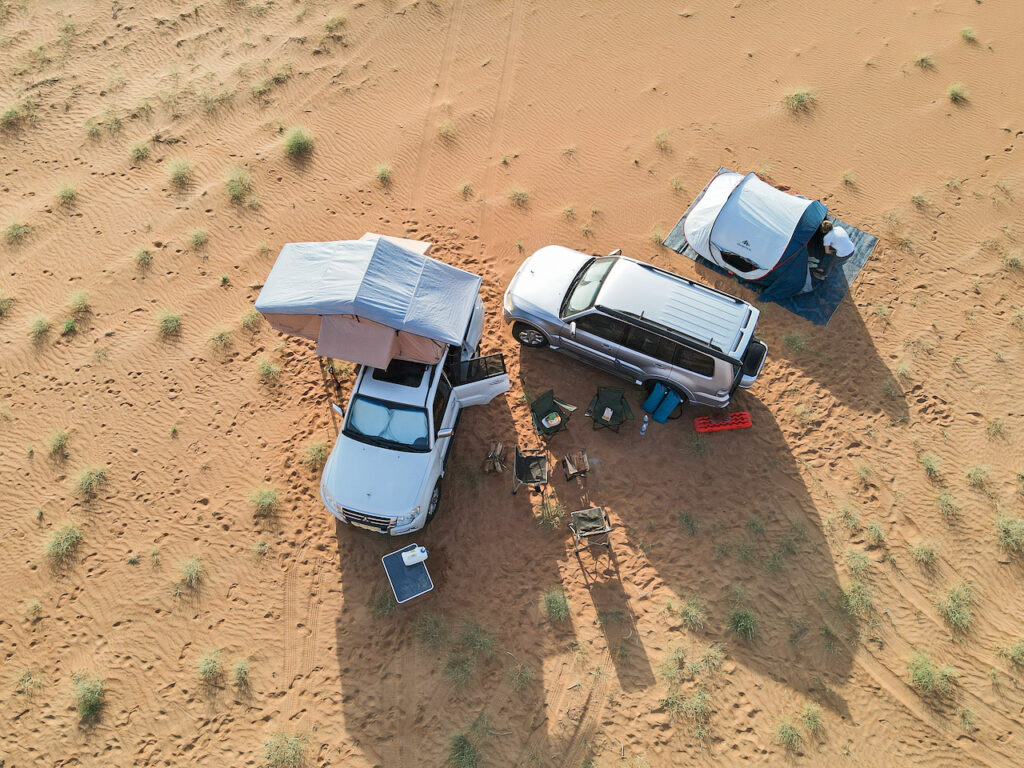
Petrol is extremely cheap. It costs me 18 OMR (£40) to fill my large 4WD… Prices are regulated by the government, so are the same at all petrol stations.
Be aware that adding a visit to Musandam will add at least an extra £100 to your logistics budget. Car rental companies will charge an additional fee for UAE insurance (you must drive through the UAE to get to Musandam from Oman), and you will need to cover the cost of UAE exit fees. You will also need to factor in the cost of a multi-entry visa for Oman.
After car hire, food is likely to be your next largest cost. Clearly this will vary substantially based on how often you eat out, versus cooking for yourselves. A camping stove is a cheaper – and easier – option than lighting a BBQ or campfire every night.
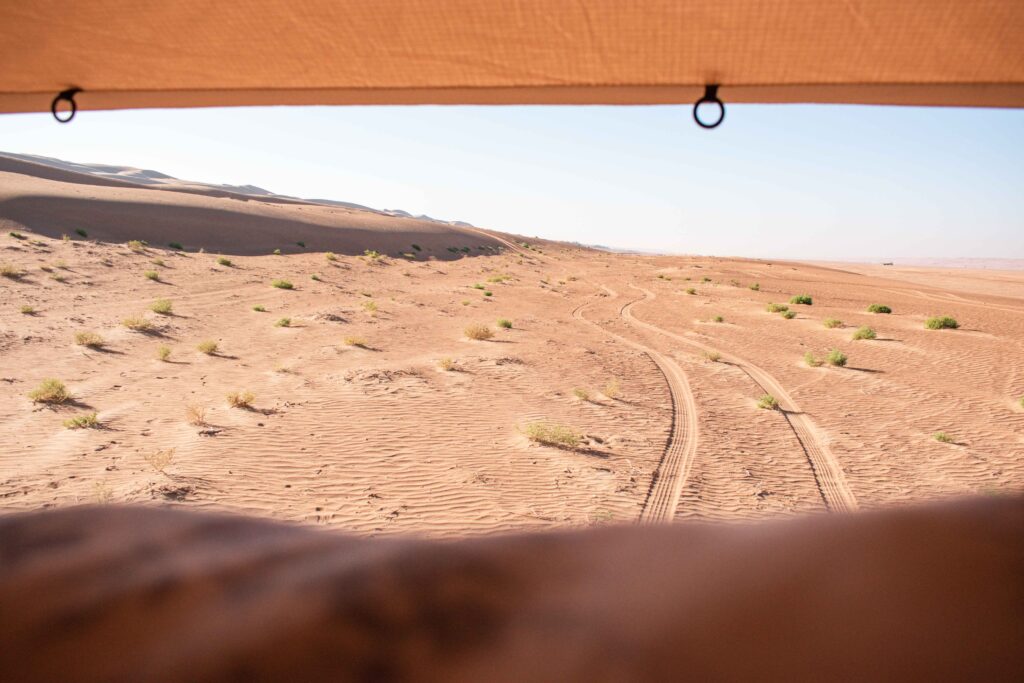
Accommodation can also be a very significant expense in Oman – although hopefully this guide will tempt you to camp, and therefore save you some cash! In addition to the advice below, check out my guide to camping in the desert for tips on where to pitch your tent. For the nights you want a few more creature comforts, smaller guesthouses will be significantly cheaper than the international brand hotels. You can find many local guesthouses listed on Booking.com.
If you are thinking of moving to Oman as an expat, you might want to have a look at a more detailed article I wrote on the cost of living in the Sultanate.
WHICH CAR DO I NEED – 4WD OR 2WD?
There are lots of guides that will tell you that a 4WD is absolutely essential. Or that despite the significant price difference, you will actually save money overall by hiring a 4WD instead of a 2WD, as you can camp instead of splurging on hotels. Well, I shall have to respectfully disagree!
It is perfectly possible to have a great road trip through Oman with a 2WD. A 2WD certainly doesn’t stop you from camping in some beautifully wild locations, and you will be able to get to some spectacular wadis and some historic forts. It is also possible to hire drivers or arrange hotel pickups if you want to go to the most popular 4WD destinations – Wahiba Sands and Jebel Akhdar.
That said, a 4WD will allow you to get away from the crowds, find some of Oman’s best camp sites and explore some of Arabia’s real wildernesses. Oman is also a great off road driving destination, with some incredible mountain passes and desert crossings to explore. So, if your budget will stretch, I would definitely opt for a 4WD.
Check out my suggested 10 day 4WD and 2WD itineraries, to help you work out which option is best for you.
DRIVING IN OMAN
Drive on the right. Road signs are in both English and Arabic. Once you are out of Muscat, traffic is minimal making the driving straightforward – just watch out for camels, donkeys and goats in the road in more rural areas.
Speed limits are 100km/h or 120km/h on highways, and 60km/h in built up areas. Don’t be tempted to try and keep up with everyone speeding around you. Oman has the depressing honour of having the highest road traffic accident rate in the Gulf. Speed limits are monitored by radar cameras. If you get a fine, your car rental company will charge you the speeding ticket (usually 10 OMR) a few weeks after you leave.
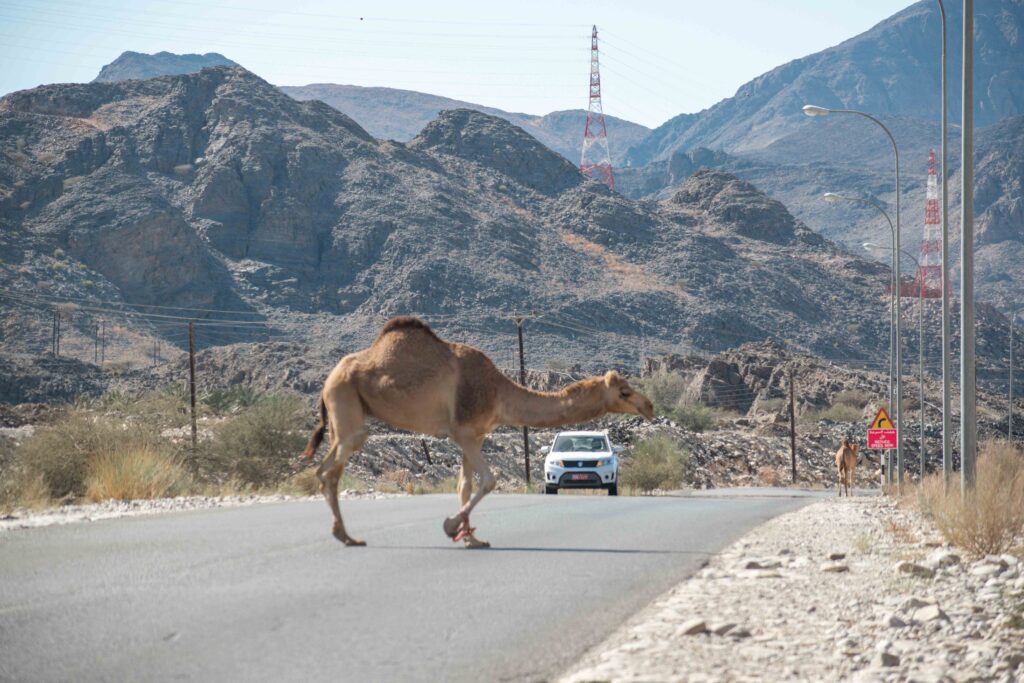
There are cameras on red lights – penalties are severe, including a possible night in jail. Expect to see Muscat locals stopping way back from the line due to rumours about just how sensitive the red light cameras are. Anticipate speed bumps everywhere – including the scary 25% that aren’t signposted or painted…!
Paper maps are not common in Oman, and you will struggle to find a detailed road atlas akin to what you might be used to in the UK or Europe. Waze and Google Maps work extensively, although avoid relying entirely on them in more remote areas. For more adventurous trips, we use the excellent Gaia GPS navigator app. It is particularly good for following tracks when you don’t have internet as routes can be downloaded in advance. You can pick up an e-SIM on arrival at the airport in the arrivals lobby. Ooredoo currently offer 8GB SIM for 5 OMR (about £11).
TOP TIPS FOR STAYING SAFE ON AN OMAN ROAD TRIP
Keep a large bottle of water in your car. It is recommended to travel with at least a few litres per person, especially in the scorching summer months. It is easy to quickly overheat whilst driving without realising.
Don’t let your fuel tank dip below half full (yes that does include you, Husband…). On the main highways there are petrol stations very regularly, but in more remote areas or when heading off road, be sure to top up before you start. If travelling in the Empty Quarter you will need to consider carrying additional fuel.
Take plenty of food and snacks. Outside of the larger towns, food options are more restricted and in some places you will be limited to service stations and tiny tea houses.
Driving on sand is an entirely different skill, and a desert excursion requires much more planning. Do not attempt anything you aren’t confident with, and travel in convoy where possible. Check out my guide to camping in the Omani desert for some top tips to keep you safe.
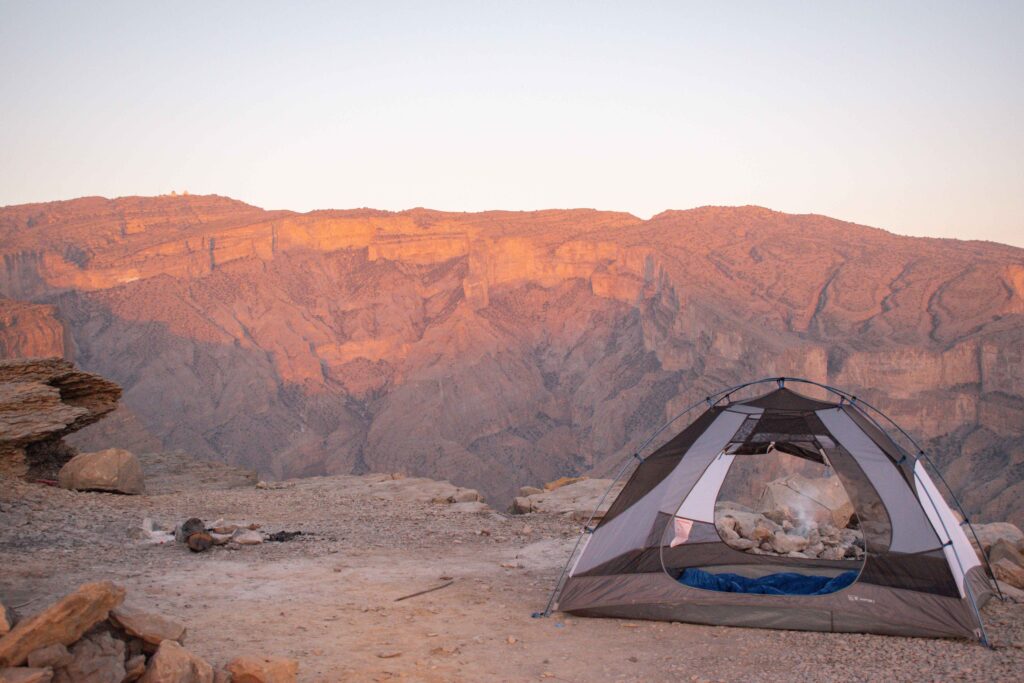
WHERE TO CAMP
Wild camping is legal across Oman and a very popular weekend pastime for Omanis and expats alike. But there are some guidelines to follow to ensure you have a safe trip.
Do not camp in protected environments. The immediate area around the turtle reserve at Ras al Jinz prohibits camping, but I would avoid camping all along that stretch of coast, to avoid damaging the turtle nesting grounds unintentionally. Landing, and camping, on the Daymaniyat Islands outside of officially permitted months (November – April), is also prohibited.
Avoid camping near to any dwelling, and away from villages. Never camp in wadis, no matter how predictable you think the weather seems. Rain further up the mountain may not be visible down in the wadi, and yet can cause sudden, and significant, flash flooding. Sadly, every year people die whilst camping in wadis in Oman.
If you’re planning to camp on or near the beach, be sure to check the tides. Once there look for signs of the high water mark and camp a few metres back – no one wants to wake up soggy!
Whenever you camp follow the Leave No Trace principles. Be sure to take *all* of your rubbish away. Sadly, many of Oman’s most beautiful landscapes are increasingly blighted by litter.
I have suggested some of my favourite camping spots in my 2WD and 4WD itineraries, and in my desert camping guide. Otherwise, i-Overlander (iOS/Android) is also a great place to start. There are usually a few options marked, often with a short description and sometimes even a picture. The excellent Oman Off-Road guidebook also marks suggested camping spots on all their routes. You can usually get a copy in the bookshop in Muscat Airport, Spinney’s at the Wave/Al Mouj or sometimes in the Al Fair supermarkets.
CAMPING KIT
There are no “fixed” campsites in Oman, so do not expect to find communal facilities such as showers or bathrooms. Most service stations and malls have bathroom facilities, but you may wish to consider staying at a hotel or guesthouse every couple of nights to freshen up.
If you don’t bring your own, camping kit is available cheaply in all the big supermarkets in Muscat. Sultan Centre, Lulu’s and Carrefour have a good selection, and there is a Decathlon in Mall of Oman for more robust (but also more expensive) kit. If you plan to buy camping equipment in Oman, be sure to consider what you will do with it at the end of your trip so as not to simply generate waste.
At a minimum, I suggest you need:
- A tent – given the rocky ground and desert landscapes, tent pegs can often be hard to get in so bear that in mind when choosing your tent. More on renting a roof tent below if you fancy trying one out;
- Sleeping mats – this is more than a nice to have, the ground in Oman is almost always sharp and rocky. For the same reason you might want some kind of ground sheet for your tent;
- Sleeping bags – don’t underestimate how cold it gets at night in the mountains and in the desert, especially in the winter;
- Pillow;
- Camping chairs – not strictly essential, but a game changer for comfort if you are camping for several nights;
- Headtorch;
- Camping stove and gas;
- Cookware set with eating utensils;
- Sharp knife or multitool;
- Solar battery pack for charging phones and cameras.
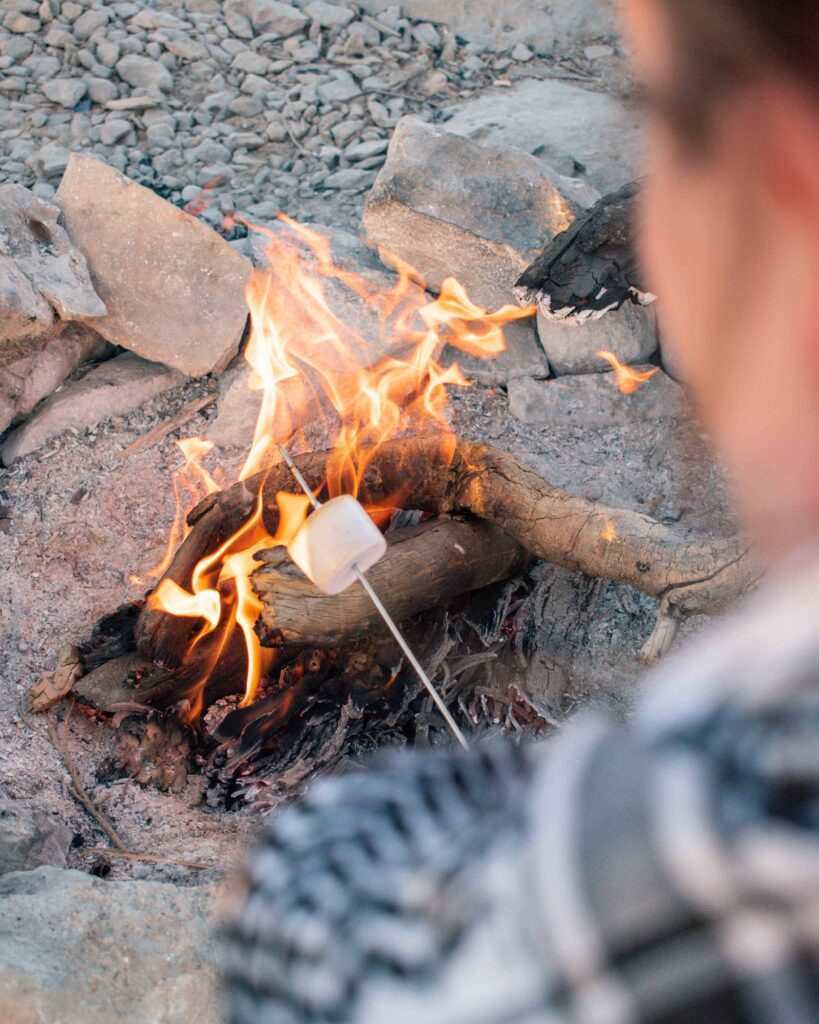
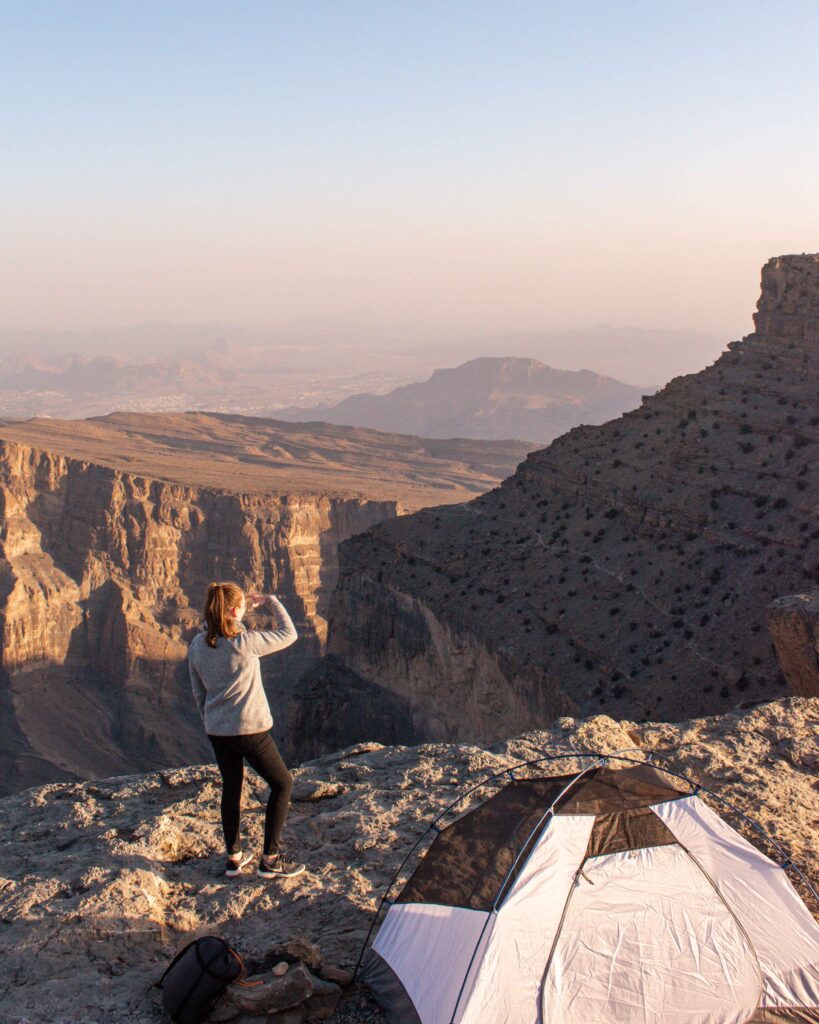
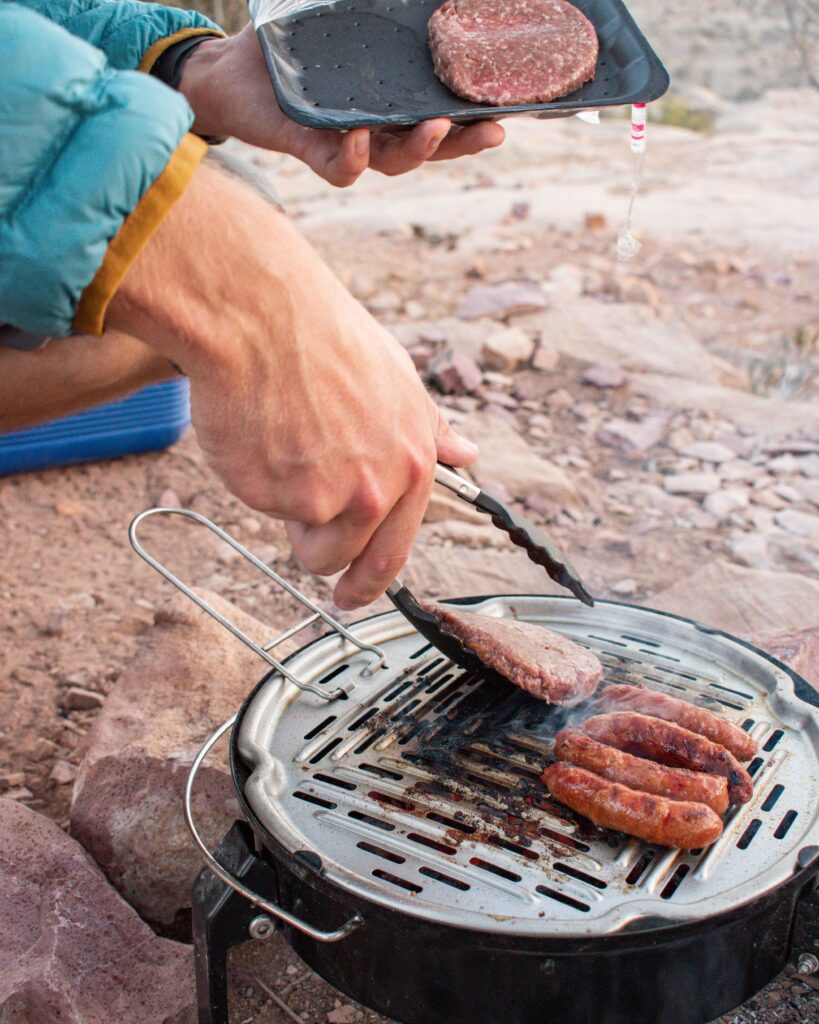
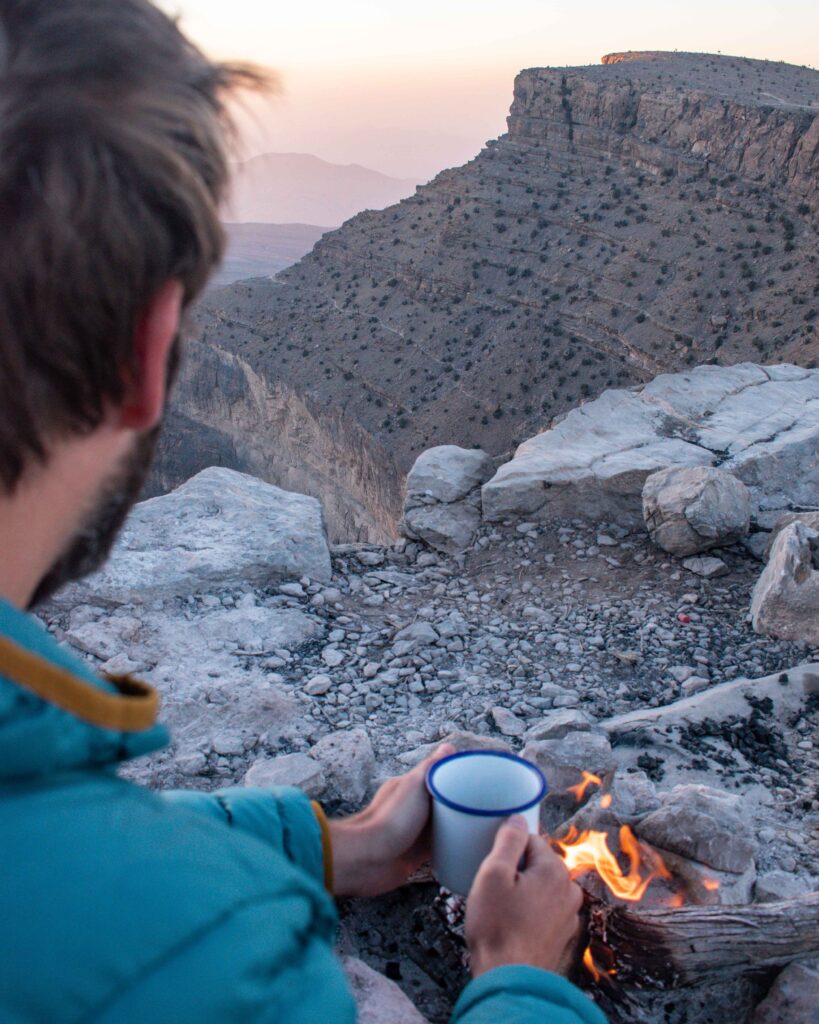
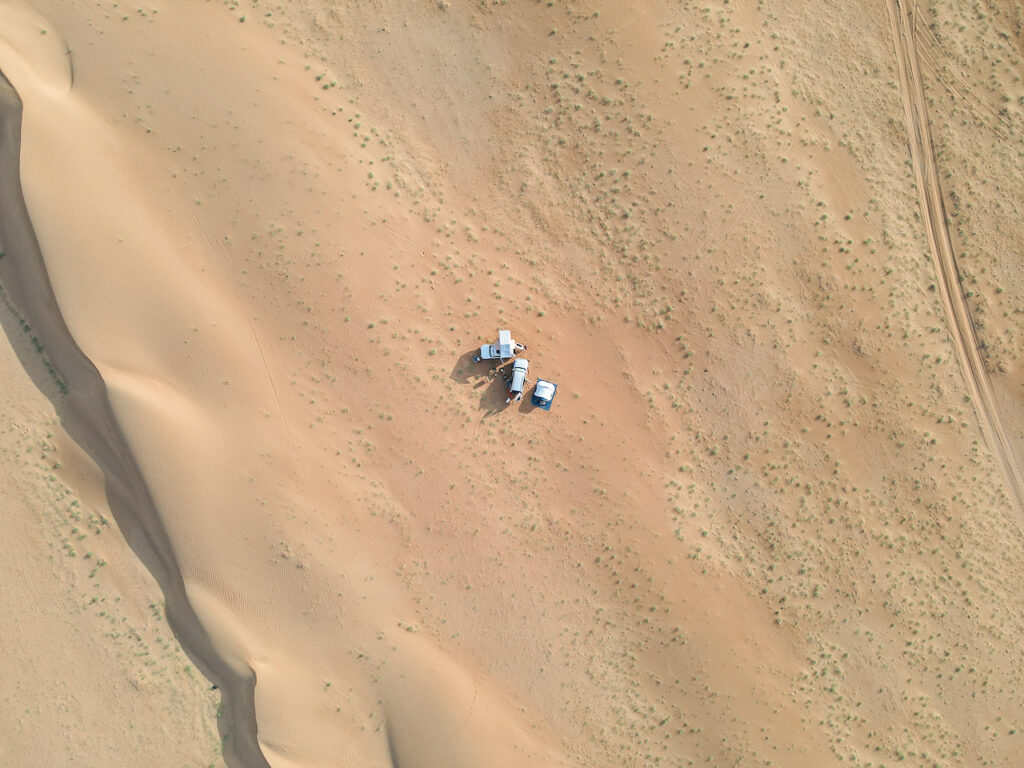
ROOF TENTS
If you follow along with our adventures on Instagram you will know we have a roof tent fitted to the top of our trusty Mitsubishi Pajero. The Husband and I gave it to each other as our Christmas gift, the first year we lived in Oman and it is without doubt one of the best purchases we have ever made! Roof tents are popular across Oman, and you will see a fair number of people using them. I am not sure how I will ever cope with returning to a ground tent when we leave Oman!
If you fancy a go yourself, Nomad Tours can arrange rental cars with rooftop tents in a variety of sizes. Their packages also include all camping kit.
CREEPY CRAWLIES
There are some poisonous animals indigenous to Oman, most notably snakes and scorpions. The venomous horned viper, carpet vipers, puff adder and cobra snakes are all found in Arabia, although all are rare. You are more likely to hear a camel amble past in the night, than encounter a slithery companion in your tent.
Good advice is to wear shoes around camp, and make sure you give shoes and other clothes a good shake in the morning to ensure they have no new inhabitants. The same advice applies when packing away your tent. When turning over rocks always do so with your shoed foot, and not a bare hand, to check no one is sheltering in the shade sun underneath! Always fully close your tent at night.
EATING AND DRINKING
Tap water is generally safe to drink in Oman, but almost all residents drink bottled water. If you want to reduce the amount of plastic waste this will inevitably generate, consider packing a small water filtration device and refilling bottles at guesthouses or service stations. You could ask at local mosques, outside of prayer times, if they would allow you to fill bottles from the ablution blocks.
In larger towns, Lulu and Carefour hypermarkets offer the widest range of produce and the lowest prices. Costs are comparable to food shopping in the UK and Europe, with branded or “western” products at a premium. They often also have deli-style counters, which serve decent hot food such as curries, samosas and noodles if you are looking for a budget option and a night off manning the camp stove! Smaller, local grocery shops will offer basic supplies if you are happy to eat relatively simply.
Eating at hotels will always come with a significant mark up, but it is certainly possible to eat well on a budget whilst on a road trip in Oman. In Muscat head to Ruwi for some of the best Indian and Pakistani food you can find anywhere. Have a look at my foodie guide to Muscat for more ideas. Outside of the capital, make use of the low key tea houses, most of which also serve simple meals, found in all towns and most petrol stations. A filled chapati is a cheap, filling and delicious meal.

OMAN CAMPING ROAD TRIP FAQs
Do I need a visa?
Most visitors coming for less than 14 days can travel visa free, with proof of accommodation and return flight. If you plan to stay longer, you can apply for a visa in advance online, or buy a visa on arrival at Muscat airport. E-visas are valid for 30 days and prices vary depending on how soon you wish to travel.
Remember that if you plan to also visit Musandam, you will need a multi entry visa – or multiple single entry visas.
What is the best way to get around?
Other than taxis in main cities, public transport is almost non-existent. Renting a car is by far the best option. Rental vehicles can be picked up at the airport, or most companies will deliver a car to your hotel for minimal extra charge. Car rentals are big business here – many Omanis rent cars regularly to try new models – so shop around on comparison sites and you are likely to find a good deal. Where you want to go on your Oman camping trip will determine the vehicle you need – if you want to go further afield a 4WD offers the most freedom, but is certainly not the only way to see the best of Oman. Check out my 2WD and 4WD itineraries to help you decide, and the advice above.
What should I wear in Oman?
As with any Muslim country, you should dress modestly but there is no need for a headscarf, nor to cover up entirely. Clothes should not be too clingy, low cut or see through, and must cover shoulders and knees. This applies to both men and women. If you are visiting a mosque you must be fully covered from the wrists to the ankles, and women must also cover their hair.
Fines of 100 OMR to 300 OMR (£200-£600) can be issued to those showing knees and shoulders in public places, but more often than not you will simply be asked to cover up. Many tourist sites have a display board setting out the expected dress code, in both English and Arabic. In resorts you can dress as you wish, but you will likely be asked to cover swimwear whilst walking around the hotel.
Omani women wear abayas (long cloaks, usually black) and head scarves. Men wear a dishdasha (an ankle length white robe, known as a thobe elsewhere in the region). Omani dishdashas have a small tassel attached to the collar, designed to be dipped in perfume. Omani men also wear an embroidered cap (kumma) or a turban.
So what should I actually pack?
I live in midi skirts and loose t-shirts most of the year round, and have a couple of robust linen trousers that are perfect for road trips and exploring. If you are heading up to the mountains or into the desert, you will want a jumper for the chilly evenings, and some good walking shoes. Winter nights camping can get genuinely cold so bring layers. When swimming in wadis, take your steer from those around you. If the visitors are predominantly Omani families, you should swim in a t-shirt at least, and ideally also a pair of loose shorts or leggings. If there are a large number of tourists, you are likely to be fine to swim in a swimming costume (never a bikini).
When is the best time of year to visit?
October to April is pleasantly warm (25-30C), although nights in December and January can be pretty chilly. Summer (May–September) is extremely hot and very humid – daytime temperatures are a scorching (and pretty unbearable) 45-50C. No matter how brave you think you are, if you are planning a road trip, avoid the summer. Unless you are heading to the southern Dhofar Region, it is just a bit miserable.
Ramadan makes travelling around Oman a bit trickier – not impossible, it just needs much more planning and flexibility. Accommodation tends to be very busy for the Eid weekends. Although if you are planning a road trip through Oman during Islam’s Holy Month, have a look at my guide to experiencing Ramadan as an expat to make the most of the experience.
You might also want to have a look at the more detailed guide I wrote for A Way Abroad, on the pros and cons of visiting Oman throughout the year.
Is Oman safe to visit?
Crime rates are low, and female travellers are unlikely to encounter issues if you are respectful of local customs and dress. But as with anywhere, it is sensible to take precautions if you are a female traveller, or visiting solo.
The Omanis are deeply proud of their country, traditions and Sultan. Steer clear of any topics that are socially contentions. Criticising the Royal Family is punishable by law. Likewise, disrespecting Islam will be very strictly dealt with. Swearing loudly or rude hand gestures are likely to get you into trouble with the police. It is a criminal offence to be drunk in public. As with most places in the world, avoid photographing military or official buildings.
Asking an Omani man about the women in his family (including his wife or daughters) is considered impolite. Instead, stick to something generic such as wishing his family well. More often than not, the Omanis I meet, especially of a younger generation, do talk about their female family members, but let the person you are speaking to take the lead to avoid causing discomfort. At multi-generational social occasions traditional social norms are usually more strictly adhered to, and women will often sit together, with the men at another table.
There are lots more guides to explore to help plan your camping trip to Oman – and the rest of the Middle East – across Faraway Dispatches, but if you have a specific question let me know in the comments below and I am more than happy to help!




Leave a Reply